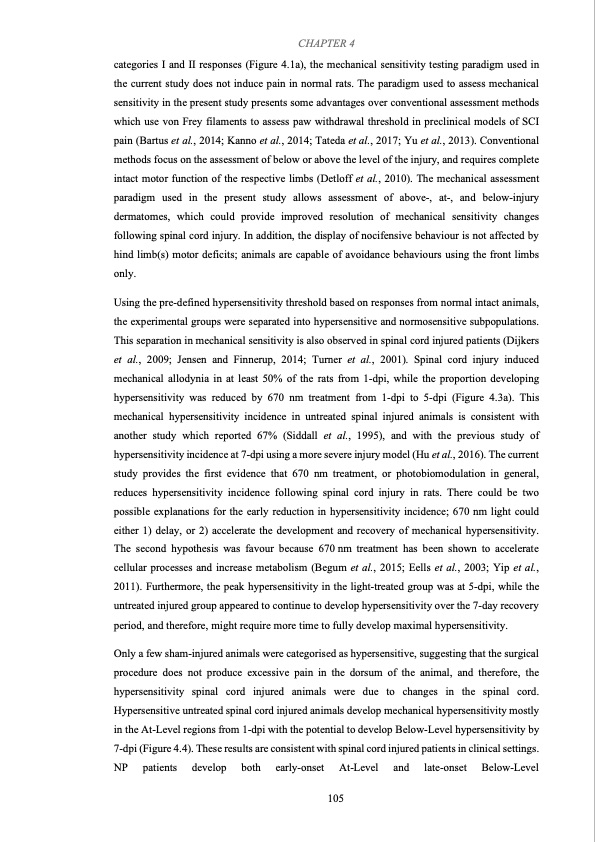
PDF Publication Title:
Text from PDF Page: 119
CHAPTER 4 categories I and II responses (Figure 4.1a), the mechanical sensitivity testing paradigm used in the current study does not induce pain in normal rats. The paradigm used to assess mechanical sensitivity in the present study presents some advantages over conventional assessment methods which use von Frey filaments to assess paw withdrawal threshold in preclinical models of SCI pain (Bartus et al., 2014; Kanno et al., 2014; Tateda et al., 2017; Yu et al., 2013). Conventional methods focus on the assessment of below or above the level of the injury, and requires complete intact motor function of the respective limbs (Detloff et al., 2010). The mechanical assessment paradigm used in the present study allows assessment of above-, at-, and below-injury dermatomes, which could provide improved resolution of mechanical sensitivity changes following spinal cord injury. In addition, the display of nocifensive behaviour is not affected by hind limb(s) motor deficits; animals are capable of avoidance behaviours using the front limbs only. Using the pre-defined hypersensitivity threshold based on responses from normal intact animals, the experimental groups were separated into hypersensitive and normosensitive subpopulations. This separation in mechanical sensitivity is also observed in spinal cord injured patients (Dijkers et al., 2009; Jensen and Finnerup, 2014; Turner et al., 2001). Spinal cord injury induced mechanical allodynia in at least 50% of the rats from 1-dpi, while the proportion developing hypersensitivity was reduced by 670 nm treatment from 1-dpi to 5-dpi (Figure 4.3a). This mechanical hypersensitivity incidence in untreated spinal injured animals is consistent with another study which reported 67% (Siddall et al., 1995), and with the previous study of hypersensitivity incidence at 7-dpi using a more severe injury model (Hu et al., 2016). The current study provides the first evidence that 670 nm treatment, or photobiomodulation in general, reduces hypersensitivity incidence following spinal cord injury in rats. There could be two possible explanations for the early reduction in hypersensitivity incidence; 670 nm light could either 1) delay, or 2) accelerate the development and recovery of mechanical hypersensitivity. The second hypothesis was favour because 670 nm treatment has been shown to accelerate cellular processes and increase metabolism (Begum et al., 2015; Eells et al., 2003; Yip et al., 2011). Furthermore, the peak hypersensitivity in the light-treated group was at 5-dpi, while the untreated injured group appeared to continue to develop hypersensitivity over the 7-day recovery period, and therefore, might require more time to fully develop maximal hypersensitivity. Only a few sham-injured animals were categorised as hypersensitive, suggesting that the surgical procedure does not produce excessive pain in the dorsum of the animal, and therefore, the hypersensitivity spinal cord injured animals were due to changes in the spinal cord. Hypersensitive untreated spinal cord injured animals develop mechanical hypersensitivity mostly in the At-Level regions from 1-dpi with the potential to develop Below-Level hypersensitivity by 7-dpi (Figure 4.4). These results are consistent with spinal cord injured patients in clinical settings. NP patients develop both early-onset At-Level and late-onset Below-Level 105PDF Image | Effects of Red Light Treatment on Spinal Cord Injury

PDF Search Title:
Effects of Red Light Treatment on Spinal Cord InjuryOriginal File Name Searched:
Thesis_Di Hu_final.pdfDIY PDF Search: Google It | Yahoo | Bing
Cruise Ship Reviews | Luxury Resort | Jet | Yacht | and Travel Tech More Info
Cruising Review Topics and Articles More Info
Software based on Filemaker for the travel industry More Info
The Burgenstock Resort: Reviews on CruisingReview website... More Info
Resort Reviews: World Class resorts... More Info
The Riffelalp Resort: Reviews on CruisingReview website... More Info
| CONTACT TEL: 608-238-6001 Email: greg@cruisingreview.com | RSS | AMP |